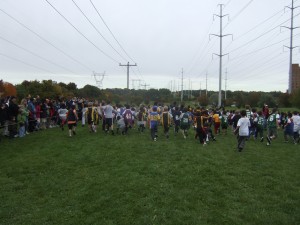
The first week of school is over. Routines are starting to gel, kids are on their best behaviour and starting to make friends. Teachers are breathing a sigh of relief. It’s the honeymoon period for elementary teachers. This glistening doorway of opportunity, lit by September magic, will not stay open long.
Invite all the kids in, before that dull ‘day-to-day feeling’ arrives. Hook them with creativity. Kids love to be stimulated and challenged to imagine. They want your teaching to take them places they could never go on their own. Surprise them and help them stretch their minds, and they will know you are on their side when things get harder.
With this goal in mind, here are a few book suggestions for September:
Steal Like an Artist. Long books on creativity can be counterproductive. This short book by Austen Kleon is full of art, poetry ideas and inspiration for teacher-artists, or anyone who wants to live more creatively. I recently reread it and find it excellent for visual, material, dramatic and literary artists.
Kleon suggests that you take whatever artistic thing you do to procrastinate and do more of it. He gives practical advice for artists like ‘learn about money,’ and describes ethical ways to draw inspiration from the work of others. One of his big projects is Newspaper Blackout, a website which begat a bestselling poetry book.
You could have a lot of fun doing newspaper blackout poetry with your students. How? Students take fat markers and strike out words on a newspaper page, until the remaining words form a poem. The result might be a simple message like “Eat your vegetables!” More sophisticated students could juxtapose the title of the original article against their ‘secret’ message. For example, they could take an article about war and block out words to reveal “give peace a chance,” or “support our troops.”
Shel Silverstein’s Where the Sidewalk Ends appeals to boys and girls. It’s not new material but his poem, “Sarah Cynthia Sylvia Stout Would Not Take the Garbage Out,” is a guaranteed giggle. I introduce it by telling kids how my Dad used to recite it to me when I was little. “Sylvia Stout,” is a good model for student ‘chore’ poems or poems about garbage. With Green Philosophy paramount in modern schools, it’s time for young Silversteins-in-the-making to write recycling poems. If you like his style, there are videos of many of his poems and songs available on YouTube. “I’m Being Eaten by a Boa Constrictor,” is fun to sing with young children. Just be careful, not all Silverstein material is safe for school. Ever heard “Never Bite a Married Woman on the Thigh?”
Make your own crazy character mix and match flip book. Have you ever played this game? Fold over a small stack of paper and staple to make a booklet. Make two scissor cuts to divide the book in three, top-to-bottom. Students draw the head of a character or creature in the top box, the body in the middle and the feet at the bottom. Students open the booklet to the next page and pass it to the next student. This student continues by drawing another monster, athlete, animal or character, aligning the head, body and legs in the correct box. This process continues until all pages are filled and the books are returned for sharing, flipping and discussing. This little art and creativity project can be a jumping off point for writing “What if” stories or just a fun get-to-know you activity. Enjoy!
‘What if’ story starters:
- What if you woke up with the legs of an Olympic runner?
- What if you had the chest of a fish and could breathe under water?
- What if you had the body of a bird and could fly?
- What if your head was an octopus, legs and all?
- What if you woke up with a hairy gorilla body?
- What if you woke up with the pitching arm of a pro baseball player?
Here are some examples of different flip books:
http://www.firstpalette.com/Craft_themes/People/Body_Flip_Book/Body_Flipbook.html
http://sketchbookchallenge.blogspot.ca/2011/11/flip-book-animals.html
This one is just for writers. As a writing book junkie, I procrastinate by reading about writing. What better way to goof off and still feel productive? In my home office, I have a bookshelf of reference and writing advice books. Other titles I’ve purchased as ebooks or borrowed from the library. I’m not proud of my addiction, but it puts this next statement in context.
Elizabeth Lyon’s Manuscript Makeover: Revision Techniques No Fiction Writer Can Afford to Ignore, is the best book on fiction editing I have ever read. Reading it feels like having an editor at my side, pointing out potential flaws and providing techniques for reworking and deepening the second draft of my novel-in-progress. The chapters on polish and proofreading are short compared to those on style, craft and characterization. This is no grammar book for beginners.
If you want to do more substantive editing before you submit your work to a professional, this book is an excellent reference to read, and reread. The checklists at the end of each chapter help diagnose weak points and prioritize the complex processes of rewriting: adding, subtracting and re-imagining to enrich voice, style and emotion.